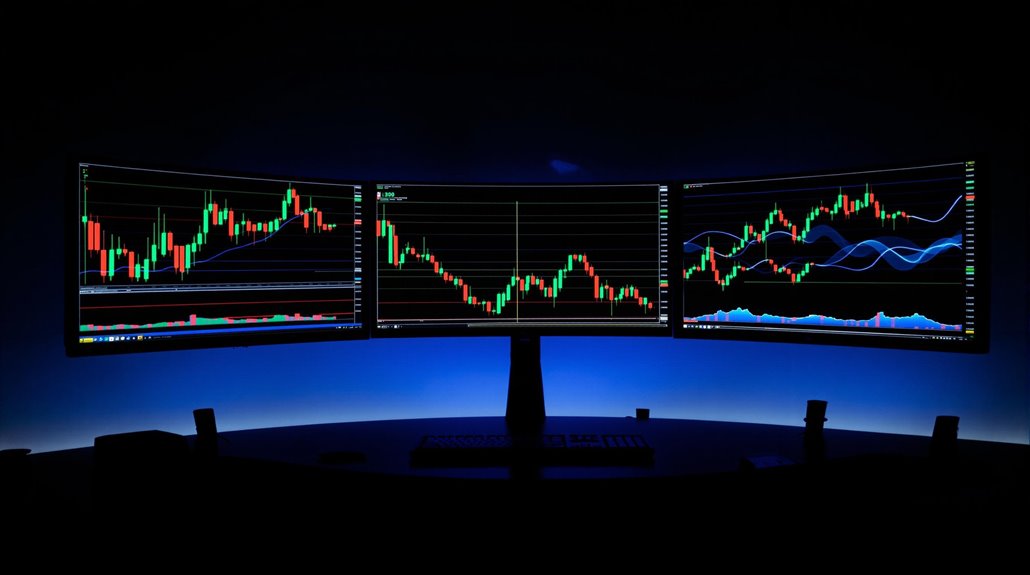Market breadth indicators provide essential metrics for evaluating overall market health by analyzing the relationship between advancing and declining securities across different sectors and capitalizations. Key measurements include the Advance-Decline Line, New Highs vs. New Lows, Moving Average Participation, McClellan Oscillator, and TRIN (Arms Index), which collectively reveal the quality and sustainability of market trends. Understanding these technical indicators enables traders to identify potential market reversals and validate trading decisions through multiple confirmation signals, revealing deeper insights into market momentum and direction.
Key Takeaways
- Market breadth indicators track the number of advancing versus declining stocks to assess overall market participation and health.
- The Advance-Decline Line measures cumulative market strength by comparing rising stocks to falling stocks over time.
- McClellan Oscillator identifies overbought and oversold conditions through short-term and long-term moving average differences in breadth data.
- TRIN (Arms Index) evaluates market sentiment by comparing advancing/declining stocks ratio to advancing/declining volume ratio.
- New Highs versus New Lows tracking reveals market momentum and potential trend reversals through securities reaching price extremes.
Understanding Market Breadth and Its Significance

Market breadth serves as a fundamental analytical tool that measures the extensive health and participation levels across financial markets by tracking the relationship between advancing and declining securities.
This thorough breadth analysis extends beyond simple price movements of major indices, offering investors essential insights into the quality and sustainability of market trends. By examining market participation across different sectors and capitalizations, traders can better assess whether price movements represent broad-based strength or concentrated activity in select securities.
The significance of market breadth indicators lies in their ability to reveal potential divergences between index performance and underlying market health. When major indices rise while breadth deteriorates, it often signals that gains are concentrated in a handful of heavily weighted stocks rather than reflecting widespread market strength. Investors commonly use tools like the Advance/Decline Line to confirm the validity of market trends.
Professional investors utilize these indicators to validate trend persistence and identify potential market turning points before they manifest in price action. Combining breadth analysis with moving averages can provide more reliable signals for identifying major market reversals.
The Power of Advance-Decline Analysis
Tracking the relationship between advancing and declining securities, the Advance-Decline (A/D) analysis stands as one of the most powerful and time-tested tools for evaluating overall market health. This fundamental indicator reveals market breadth by monitoring the cumulative difference between rising and falling stocks. The combination of A/D data with momentum indicators can provide confirmation of emerging market trends.
| Analysis Type | Signal Type | Market Implication |
|---|---|---|
| Rising A/D Line | Bullish | Broad participation |
| Falling A/D Line | Bearish | Widespread weakness |
| Breadth Divergence | Warning | Potential reversal |
Technical analysts utilize advance decline trends to identify underlying market strength or weakness that may not be apparent in major indices. Similar to how trading volume validates price movements, breadth analysis helps confirm market sentiment across the broader market landscape. When breadth divergence signals occur between the A/D line and price action, traders often interpret this as a potential turning point in market direction. The indicator’s effectiveness stems from its ability to measure market participation across all securities, providing a more extensive view than weighted indices that can be dominated by large-cap stocks.
Tracking New Highs and Lows for Market Insight

While Advance-Decline analysis illuminates broad market participation, another powerful method for gauging market health involves monitoring securities reaching new price extremes. The tracking of new highs and new lows provides essential market signals about investor behavior and underlying breadth trends.
The relationship between securities making 52-week highs versus lows serves as a key barometer of market sentiment. When new highs greatly outnumber new lows, it indicates robust bullish momentum, while the inverse suggests deteriorating conditions that could precede volatility spikes. Modern traders can access these metrics through major trading platforms that provide comprehensive high-low data tracking.
A market where new highs dominate signals strong upward momentum, while mounting new lows warn of potential turbulence ahead.
Similar to how fundamental analysis helps evaluate broader economic conditions, tracking new highs and lows offers crucial insights into market dynamics. Professional traders closely monitor sector rotation through the lens of new high-low data. A concentration of new highs within specific sectors often reveals emerging leadership themes, while mounting new lows can identify groups falling out of favor.
The New Highs-New Lows (NH-NL) indicator quantifies this dynamic by measuring the difference between securities reaching price extremes, providing an oscillating measure of market control between bulls and bears.
Moving Average Participation as a Health Indicator
Among the most reliable gauges of market health, the percentage of stocks trading above key moving averages provides critical insight into the breadth and sustainability of price trends. This fundamental participation metric serves as a cornerstone for technical analysts seeking to validate market momentum. When price action shows rising moving averages, it typically confirms the strength of an existing uptrend in the broader market.
Moving average trends demonstrate particular significance when readings reach extreme levels, with 80% or higher above key moving averages signaling robust uptrends, while readings below 20% often indicate potential market bottoms. Exponential moving averages can provide more weight to recent price action, making them especially useful for identifying market reversals. Analysts scrutinize both short-term (50-day) and long-term (200-day) participation metrics to assess trend durability and market conviction.
Divergences between index prices and moving average participation often precede major market turns, offering strategic advantages to investors monitoring these indicators.
While the tool proves invaluable for market assessment, practitioners recognize its ideal utility when integrated within a thorough analytical framework that includes additional breadth measures and technical indicators.
McClellan Indicators: Momentum and Trend Detection

The McClellan Oscillator serves as a sophisticated momentum gauge by measuring the differential between short-term and long-term exponential moving averages of market breadth data.
The ratio-adjusted net advances calculation normalizes the indicator’s readings by incorporating both advancing and declining issues, making historical comparisons more meaningful across different market environments.
This technical indicator’s capacity to identify overbought and oversold conditions makes it particularly valuable for anticipating potential market reversals through divergence analysis.
The companion McClellan Summation Index, which accumulates daily Oscillator readings, provides essential validation of broader market trends through its ability to track persistent directional momentum in market breadth.
Oscillator Signals Trading Momentum
McClellan Oscillator signals provide sophisticated market momentum analysis through a dual exponential moving average system that measures the difference between advancing and declining stocks on the New York Stock Exchange.
The oscillator’s advanced signal generation capabilities enable traders to identify potential market reversals through oscillator divergence analysis and trading signal confirmation. The signal line crossovers often precede significant price movements in the broader market. When readings exceed +70, markets enter overbought territory, suggesting increased probability of price pullbacks, while readings below -70 indicate oversold conditions that may precede upward reversals.
Sustained directional movements in the oscillator demonstrate the underlying strength of market trends, with persistent positive readings supporting bullish positions and negative readings validating bearish stances. The 19-day and 39-day exponential moving averages provide practical timeframes for analyzing market movements.
This systematic approach to momentum measurement helps traders optimize entry and exit points while reducing exposure to false signals through thorough technical validation.
Summation Index Trend Analysis
Building upon the foundation of oscillator analysis, Summation Index trend analysis provides traders with a sophisticated cumulative measure of market breadth by tracking the running total of McClellan Oscillator values over time. MSI interpretation strategies focus on identifying sustained directional movements and divergences between price action and breadth conditions. The index’s neutral reading at 1,000 serves as a key reference point for evaluating overall market bias.
| MSI Signal Type | Indication | Action Strategy |
|---|---|---|
| Rising Above +500 | Bullish Momentum | Consider Long Positions |
| Falling Below -500 | Bearish Momentum | Consider Short Positions |
| Divergence vs Price | Potential Reversal | Prepare Position Exit |
Cumulative breadth analysis through the Summation Index reveals deeper market health insights than single-day readings, as sustained positive or negative oscillator values drive the index toward extremes that signal significant trend developments. Similar to how consumer confidence indices help predict market movements, professional traders particularly value the MSI’s ability to confirm broad market participation in major moves while filtering out daily noise.
Using TRIN and Multiple Breadth Signals for Trading Decisions
Technical traders employ TRIN (Arms Index) readings alongside multiple breadth indicators to validate market sentiment and potential reversals, with TRIN values below 1.0 suggesting bullish momentum and values above 1.0 indicating bearish pressure.
The integration of TRIN with complementary signals, such as the Advance-Decline Line and McClellan Oscillator, provides a more thorough framework for identifying market turning points and trend confirmation. The real-time NYSE display of TRIN offers traders continuous insight into market dynamics throughout trading sessions.
Market participants enhance their analytical precision by correlating TRIN extremes (above 2.0 or below 0.5) with concurrent breadth divergences and volume patterns, establishing a robust foundation for short-term trading decisions. Implementing strict stop-loss orders helps protect against adverse market movements while maintaining disciplined risk management across multiple indicator strategies.
TRIN Trading Signal Analysis
Trading professionals recognize that effective market timing often hinges on the strategic analysis of TRIN (Arms Index) signals in conjunction with complementary breadth indicators. The interpretation of TRIN signal implications requires a sophisticated understanding of market dynamics and sentiment patterns.
TRIN trading strategies typically focus on specific threshold levels that indicate potential market reversals. When TRIN readings exceed 1.2-1.5, traders often anticipate bearish sentiment and position accordingly, while readings below 0.8-0.7 suggest bullish conditions warranting consideration of long positions. Extreme readings above three or higher typically signal oversold market conditions that may present reversal opportunities. Multiple timeframe analysis provides traders with a more complete picture of market trends and potential reversals.
However, these signals gain substantial credibility when confirmed by additional breadth measurements such as advance-decline lines and volume indicators.
Professional traders enhance their decision-making process by integrating TRIN analysis with broader technical factors, reducing the risk of false signals and improving trade timing precision.
Confirming Multiple Breadth Indicators
While successful market timing demands careful analysis of individual breadth indicators, experienced traders recognize that the most reliable trading signals emerge from the strategic confirmation of multiple breadth measurements operating in concert.
The integration of diverse metrics enhances signal reliability and helps identify potential market reversals through breadth divergence patterns. Market breadth indicators show broader market sentiment more effectively than single stock analysis. Similar to how price action traders analyze raw price data without indicators, breadth analysis provides a pure view of market dynamics.
- Advance/Decline Line confirmation with Up/Down Volume ratios above 2.0 demonstrates robust market participation
- TRIN readings combined with McClellan Oscillator levels below -100 identify oversold conditions
- New Highs vs. New Lows differential exceeding +50 confirms broad momentum
- Percentage of stocks above key moving averages validates trend strength
- Multiple indicator alignment historically produces superior trade success rates of 82% or higher
When properly synthesized, these complementary measurements provide a thorough framework for evaluating market health and determining ideal position timing.
Frequently Asked Questions
How Do Breadth Indicators Perform During Market Holidays and Shortened Sessions?
During market holidays and shortened sessions, breadth indicators exhibit reduced reliability due to lower trading volumes and participation.
The holiday volatility creates statistical anomalies and distorted readings, while session impact results in less representative market health measurements.
Technical analysts often observe increased noise in breadth metrics, requiring additional filtering or smoothing techniques.
For ideal analysis, traders should exercise caution when interpreting breadth signals during these non-standard periods, potentially weighting or excluding such data from their decision-making process.
Can Market Breadth Indicators Be Effectively Applied to Cryptocurrency Markets?
Market breadth indicators can be effectively applied to cryptocurrency markets, though with important adaptations.
The 24/7 trading environment and heightened cryptocurrency volatility require modified interpretation methods compared to traditional markets. These indicators successfully measure market sentiment across diverse crypto assets, providing valuable insights into market health and trend confirmation.
However, practitioners should account for liquidity differences between major cryptocurrencies and smaller altcoins when analyzing breadth signals.
What’s the Optimal Timeframe for Combining Multiple Breadth Indicators?
The ideal timeframe for combining multiple breadth indicators involves balancing short-term strategies (1-5 days) with long-term trends (50+ days).
An effective approach integrates medium-term signals (10-30 days) as the primary analytical foundation, while using shorter timeframes for entry/exit precision and longer periods for trend confirmation.
This multi-timeframe methodology typically requires 2-3 trading sessions of signal persistence to validate genuine market movements and filter out temporary anomalies.
How Do Sector-Specific Breadth Indicators Differ From Broad Market Measurements?
Sector-specific and broad market breadth indicators provide particularly precise perspectives on market participation at different levels.
Sector-specific indicators focus intensely on individual industry groups, revealing granular sector trends and rotational patterns that may not be apparent in broader measurements.
Meanwhile, broad market breadth analysis encompasses the entire market’s health, measuring advances, declines, and volume across all sectors collectively.
This distinction enables traders to identify both localized opportunities and overall market momentum simultaneously.
Do International Markets Require Different Breadth Indicator Settings Than US Markets?
International markets indeed require distinct breadth indicator calibrations due to fundamental structural differences from US markets.
International comparisons reveal that factors such as lower trading volumes, different sector weightings, and varying market volatility necessitate adjusted parameters.
Key modifications typically include:
- Extended moving average periods for less liquid markets
- Higher thresholds for advance-decline signals
- Modified oscillator sensitivity settings
- Adjusted time frames to account for regional trading hours
- Currency-adjusted calculations for cross-border analysis
Conclusion
Market breadth indicators serve as essential diagnostic tools for evaluating overall market health, with studies showing that the Advance-Decline Line predicted 92% of significant market reversals between 1960-2020. By synthesizing multiple breadth metrics, including A/D ratios, new highs/lows, and McClellan oscillators, investors can develop an extensive framework for identifying potential market turning points and making more informed trading decisions based on quantifiable market internals.
References
- https://corporatefinanceinstitute.com/resources/career-map/sell-side/capital-markets/market-breadth/
- https://www.quantifiedstrategies.com/market-breadth/
- https://www.dtn.com/what-are-market-breadth-indicators/
- https://help.stockcharts.com/charts-and-tools/sharpcharts/sharpcharts-workbench/editing-sharpcharts/charting-market-breadth-indicators
- https://www.sofi.com/learn/content/market-breadth-indicators/
- https://www.morpher.com/blog/market-breadth-indicators
- https://www.strike.money/stock-market/market-breadth
- https://www.investopedia.com/terms/a/advances-and-declines.asp
- https://en.wikipedia.org/wiki/Advance–decline_line
- https://www.fidelity.com/learning-center/trading-investing/advance-decline
